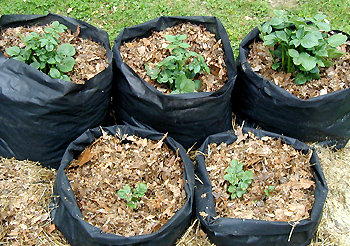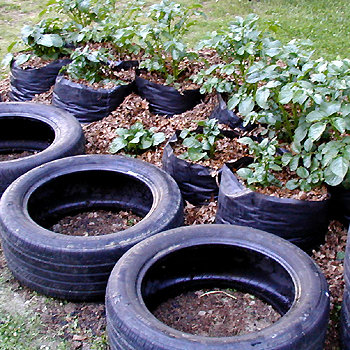





Potato plants form their tubers close to the soil surface which means they need to be shielded from the sun to keep from turning toxic green and inedible, thus the traditional "hilling up" around the plants. The hilling process can be backbreaking and there is a potential of damaging a few forming spuds. Planting potatoes in a container with little soil and lots of mulch keep the plants happy and the spuds covered.
NOTE: I do not have much soil to spare in my little yard, but I can always find some type of mulch, like shredded leaves, sawdust, hay, straw, and even bags of office-shredded paper (which I have used more than once). Those using straw bale gardening (DG forum for subscribed members) have found that potato plants love growing in the previous year's semi-composted straw (or hay) and it is perfect to mulch with, too.
My friend Pam and I prefer containers for potatoes, mainly because there is no digging to harvest. We just dump the containers and the taters fall out at our feet. There is the benefit of constant peeking to see how the little taters are doing, as well as, easy potato robbing around mid-season without harming the plant! And the composted mulch is added back to the garden beds. We have grown potatoes in the ground, raised beds, various containers, and stacked tires, so fabric grow bags sounded like a great idea.
 When fabric is used as a container, excess water easily drains away, unlike a hard surface container with a few drain holes. The cloth also allows good air circulation to prevent root rot that can sometimes take out an entire in-ground potato crop during a cold wet planting season. The roots will grow through the fabric and into the ground. The small roots growing through the side of the bags are essentially air-pruned, preventing the plant from becoming root-bound like a hard container.
When fabric is used as a container, excess water easily drains away, unlike a hard surface container with a few drain holes. The cloth also allows good air circulation to prevent root rot that can sometimes take out an entire in-ground potato crop during a cold wet planting season. The roots will grow through the fabric and into the ground. The small roots growing through the side of the bags are essentially air-pruned, preventing the plant from becoming root-bound like a hard container.
Growing potatoes in a cloth sack is a similar concept to growing them in stacked tires. I add a little soil and manure to cover the seed potato, and then mulch (some may prefer more soil). Instead of adding tires as the plants grow, the bags are unrolled, as more mulch is needed. The process continues until the bag is completely unrolled.
 The Tater Totes (or any cloth containers) are much easier to deal with than tires. They drain water more easily, allow better air circulation, are lightweight, and store folded in a drawer until the next season! I have, also, picked up my planted Totes to run from equipment during a yard project (baby backhoes need more room than you think). You cannot do that with heavy containers of soil or a stack of tires!
The Tater Totes (or any cloth containers) are much easier to deal with than tires. They drain water more easily, allow better air circulation, are lightweight, and store folded in a drawer until the next season! I have, also, picked up my planted Totes to run from equipment during a yard project (baby backhoes need more room than you think). You cannot do that with heavy containers of soil or a stack of tires!
On a whim, I created a how-to on the construction of my Tater Totes on the Instructables web site that immediately became a "Featured Instructable" (I was so proud)! If you would like more information about how the Totes are constructed and see additional photos of the planted Totes, please take a look at the slide show video (1:43 minutes).
Viewer comments offered excellent ideas for reusing fabric feed sacks, recycled shopping bags, burlap sacks, and blue jeans in lieu of the landscape fabric.
NOTE: Be wary of shopping bags created and printed with lead-based inks/paint, especially those manufactured outside the United States.
Although the Tater Tote design and use has changed a little, the concept is still the same.
See the Bag Gardens how-to (PDF file) using Hessian sacks from the Send a Cow charity.
Also, see Tater Chitting: Preparing Your Seed Potatoes for Planting for additional information about potatoes!
Copyright © www.100flowers.win Botanic Garden All Rights Reserved